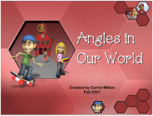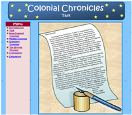As teachers, we've heard it time and time again: research has shown that the top performing students read 1 hour or more a day. In fact, the students in the top 10% read more in a year than the bottom 10% reads in their life.
But, in today's digital age, what qualifies as reading? Last week, I started to discuss Will Richardson's blog about online reading skills. Since then, I've explored a few more articles on the topic. In the September 19, 2008 issue of the Chronicle Review, an article titled Online Literacy is a Lesser Kind implores teachers to find a balance between fast-paced internet reading and slower, hard-copy reading.
By discussing a Neilson study on eye movement when reading online, they argue that digital texts receive less attention from the reader.
"…Teenagers skip through the Web even faster than adults do, but with a lower success rate for completing tasks online (55 percent compared to 66 percent). Nielsen writes: 'Teens have a short attention span and want to be stimulated. That's also why they leave sites that are difficult to figure out.' For them, the Web isn't a place for reading and study and knowledge. It spells the opposite."
Because of these learned behaviors, they argue that some classes need to remain unplugged from the digital world, focused on Victorian novels, and pencil-paper tasks.
"It is about the reading styles they employ [online]. They race across the surface, dicing language and ideas into bullets and graphics, seeking what they already want and shunning the rest. They convert history, philosophy, literature, civics, and fine art into information, material to retrieve and pass along."
While I agree with the underlining concept of maintaining a healthy balance, the facts the article uses to persuade me actually has my mind racing in a different direction. If, according to ETS results published in a NY Times article, only 39% of college freshmen reach proficiency in "core functional levels of Internet literacy" on the iSkills test, then what reading strategies do we need to be teaching our students so they can efficiently find, evaluate, synthesize, and respond to online content?
As I watch my students attempt to gather information online each year, I notice repeated behaviors. Google a few keywords, click on the first few links, check for interesting pictures, video, or sound files (not to mention colorful backgrounds and big text), and within ten minutes claim that there is nothing on the Internet about your topic. To me, this is just unacceptable--not because the kids aren't trying (I think they are!), but because I haven't given them the skills to be successful.
In the Chronicle article, they mention "racing across the surface," hunting for "bullets and images," and "shunning the rest of the text." I get frustrated with my students when they do this, but, honestly, that's what I do myself. When reading my blogroll, I skim and scan, quickly deleting posts that don't capture my interest. With so much quality content online, isn't that a reasonable strategy as a reader? I think my problem has been that I don't explicitly model my online strategies in think-alouds like I do with offline reading.
In addition to committing to use more teacher modeling, I hunted around the web for a good online highlighting tool. Awesome Highlighter is not bad, but on a few types of websites it does not work. Additionally, students have to keep their own list of URL addresses that are created when they highlight. With the organizational skills of my 5th graders, this is asking a lot. Diigo is a better choice, since it allows for highlighting and inline commenting, but it might be a little too complex for some of my students. Flowgrams seem to be my best option. All the websites for one research topic are stored in one convenient location. Students can record audio comments, highlight text, add typed notes, and embed their final compilation on our class website. They can share and discuss sources with their teams. I'd much rather have them create a Flowgram than become copy-and-paste kids, don't you?
Creating Critical Readers: Both Offline and Online
Posted by Carrie Mitton on Monday, September 29, 2008Labels: digital literacy
Subscribe to:
Post Comments (Atom)





4 comments:
Your post is very interesting to me. Today we push so much for our students to read this book or article or newspaper. I rarley see teachers using blogs from experts and having the students create their own blogs. It would open a word of reading for the students that they might find easier than just a hard copy.
As great of a tool that online reading can be I also notice trends that can be frustrating. Students have the ability to search through faster and take short cuts that often leave out key learning chances. So the question really becomes how do we balance the two forms of reading?
I do the same thing with books: skim the text until I find key words that are related to what I'm looking for. Overall, don't we need to teach students how to read, make notes, make conclusions and THEN click? I think it's a matter of when they click on more hypertext. In the end, Carrie said it very well: we need to TEACH them how to research. It needs to begin in Kindergarten and continue everyday through college!
I am also guilty of skimming, especially on the internet. I feel like my brain is making an automatic jump to skimming to protect my eyes from the computer glare!
It is important that students know when to skim and when to read for deeper meaning and detail. For instance, if I am lookiing for something very specific, I need to skim. If I am looking for a deeper understanding I need to read critically. I think that part of teaching in the digital age is teaching kids different techniques and strategies for reading varied material.
Along with this, kids need to be taught what to do with the information they find so that they do not turn into cut and paste students, but instead use the information to create new knowledge and share it with the world.
I have to admit, Carrie, that I felt the same way. I do not consider myself an logical/mathematic learner, and thus found some of the ideas in Jonassen, for lack of a better term, confusing. Looking at those huge concept maps really did little for me. This is why, when asked to make a concept map in Kidspiration, (found on my blog) I added a graphic for each section just to break it up! I definitely related more to the storytelling aspect. It would be interesting to go through and really dissect Jonnasen using the matrix from the Kuhn text.
Post a Comment